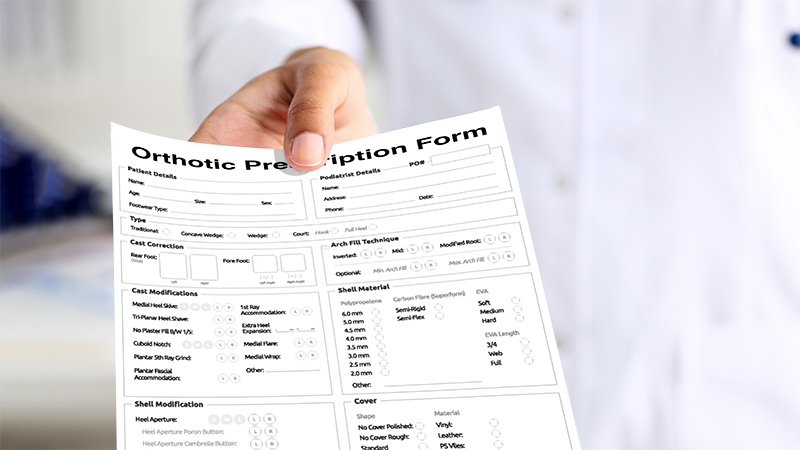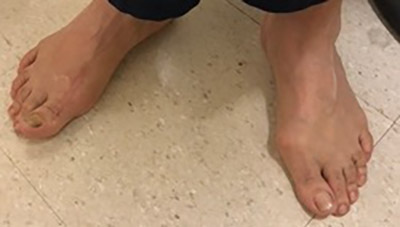
Practice Perfect 747
Simplifying the Foot Orthotic Prescription
Part 3: Finally, A Framework!
Simplifying the Foot Orthotic Prescription
Part 3: Finally, A Framework!

Like an airplane coming in for a landing, today’s Practice Perfect #747, brings us home to finish our discussion on writing foot orthosis prescriptions. Over the last two weeks we covered biomechanical principles of kinetics and kinematics, reviewed the kineticokinematic (KK) approach, and discussed the significance of the casting technique. Today we will finally arrive at the prescription itself.
But just a few last general comments to round out this topic.
- My personal preference for casting material is to use plaster because it best captures the deformity. However, a systematic review by Farhan, et al1 found 3D scanning methods were faster than other methods (including plaster casting, with which I entirely agree) with variable results when examining accuracy. More high-quality studies need to be done to fully answer this question, but based on this review, it appears 3D scanning is comparable to other methods of casting. As such, I suggest using any method that accurately captures foot structure.
- We never discussed it, but shoes are an integral part to all foot therapy, including the orthosis prescription. Without the proper shoe, an orthotic will not work correctly. Think of it this way: Would you expect an optometrist to ask about your glasses? Of course, you would. Just as glasses affect eye function, so too do orthoses and shoes.
- There are many options and materials available for foot orthoses, so it is beyond the scope of this article to cover all options. I strongly suggest reading Scherer’s textbook Recent Advances in Orthotic Therapy and speaking with your biomechanics company to understand the various options and particulars of their manufacturing process.
All right, then. Let us get to it. My suggested framework for writing a foot orthosis prescription is to keep the following six steps in mind regardless of what company is making the orthotic or what their prescription form looks like.
Six Steps to Writing Foot Orthosis Prescriptions
- Patient information - weight, foot size, shoes, and types of activities.
- Shell – material, width, heel cup depth.
- Cast corrections – arch fill, skives, heel expansion.
- Posts – intrinsic versus extrinsic, forefoot & rearfoot posts.
- Extensions & additions – many exist (ex Morton’s, reverse Morton’s, metatarsal bars, flanges, etc).
- Covers – material and length.
The key to using this method is to understand what the various orthotic modifications do to the patient’s foot and then choose the modifications, either singly or in combination, to effect that change. As an example, a classic cadaveric study by Kogler2 found that only valgus forefoot wedges decreased strain on the plantar fascia (whereas forefoot varus wedges worsened it and neither varus nor valgus rearfoot wedges had any effect). Based on this knowledge, one would prescribe a forefoot valgus wedge for patients with plantar fasciitis.
Let us look at an example using this method: a patient with painful left hallux valgus. Using the KK Approach, we find the patient’s pain is located dorsomedially at the 1st MTP joint, underlying biomechanics include hindfoot pronation with medial arch instability, and our goal of treatment is to reduce pressure and strain on the joint.

  |
A very abbreviated example of a foot orthosis prescription might be:
- Shell
- Material – 2 mm polypropylene
- Standard width
- 14 mm heel cup
- Cast corrections
- Minimal arch fill
- 4 mm medial heel skive
- Posts
- 0/0 RF post
- 3∘ forefoot valgus intrinsic post
- Extensions
- 1st metatarsal head cut out
- Reverse Morton’s extension
The overall effect of this prescription is to increase orthosis reactive force medial to the subtalar joint axis, increasing hindfoot supination. The orthosis arch closely conforms to the patient’s arch, applying further medial pressure, and – with the addition of the reverse Morton’s extension and forefoot valgus post – decreases pressure under the 1st metatarsal head. This combination of modifications decreases strain on the joint and thus the patient’s pain.
There are many different orthotic prescription modifications, and some will work better than others. Similarly, some modifications will cause problems. For example, a patient with a heavily collapsed medial longitudinal arch may not tolerate minimal arch fill or an orthosis created from a cast with a dorsiflexed hallux due to pronating excessively onto the orthosis. Perhaps the addition of a poron arch pad or heel lift might decrease this problem. Just as choosing a particular surgical procedure will have a specific effect on the patient’s foot function, so too will a foot orthosis affect foot function. An organized biomechanical thought process, with a prescribing framework consistent to all orthoses, will give you the mental tools to help your patients.

-
Farhan M, Wang JZ, Bray P, Burns J, Cheng TL. Comparison of 3D scanning versus traditional methods of capturing foot and ankle morphology for the fabrication of orthoses: a systematic review. J Foot Ankle Res. 2021 Dec;14(1):1-1.
Follow this link -
Kogler GF, Veer FB, Solomonidis SE, Paul JP. The influence of medial and lateral placement of orthotic wedges on loading of the plantar aponeurosis. J Bone Joint Surg Am. 1999 Oct;81(10):1403-1413.
Follow this link






























Comments
There are 0 comments for this article